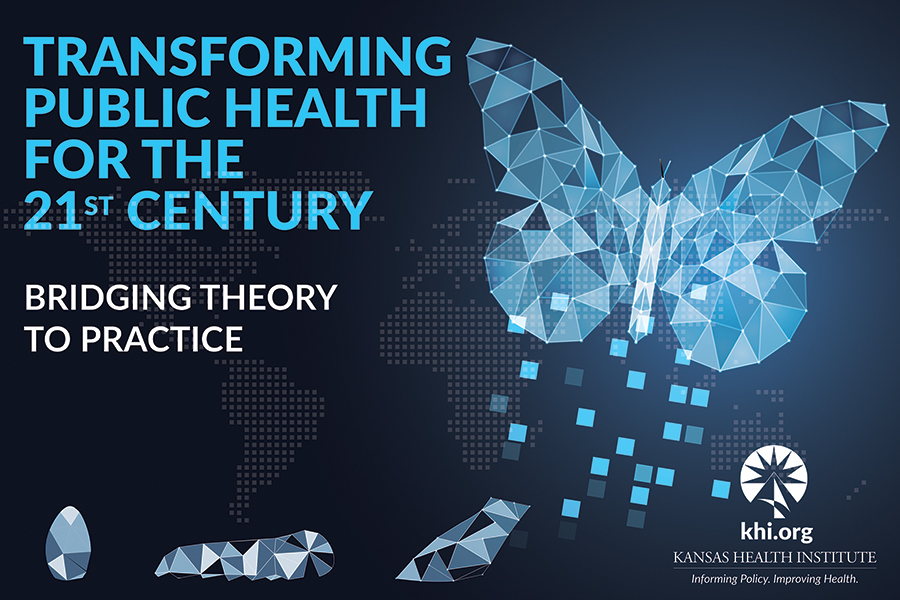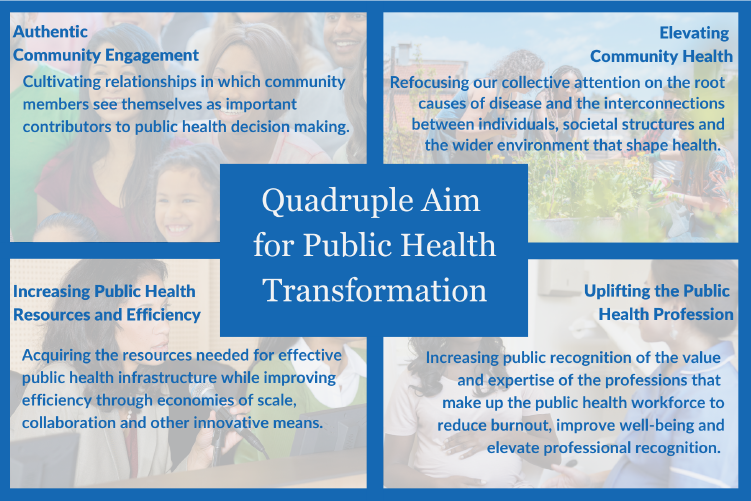Public Health 3.0 and the role of the Community Chief Health Strategist provide a dynamic vision for how public health will evolve to meet the challenges of the 21st century. While these paradigms resonate with public health professionals, their impact on broader stakeholders remains ambiguous. Surveys indicate that only a third of Americans give the public health system a positive rating for protecting the public from health threats and preventing illness. Furthermore, conflicts between public health entities and elected officials are not uncommon. Thus, public health leaders are tasked with the challenge of articulating a vision for change that aligns with and engages key stakeholders. In this post, we look at insights public health could glean from other sectors to effectively convey a transformative vision.
Reshaping the Quadruple Aim for Public Health Transformation

For over 15 years, the Triple Aim from the Institute for Healthcare Improvement, and its subsequent evolution into the Quadruple Aim, which factors in workforce needs, has provided a strategic direction for health care reform. Focused on improving patient satisfaction, population health and provider well-being, while reducing health care costs, the Quadruple Aim focuses on outcomes rather than processes. Shifting the spotlight to outcomes may enable stakeholders to grasp onto the tangible benefits of supporting public health transformation more easily. So, how can the Quadruple Aim be tailored to support public health transformation? In this post, we outline preliminary thoughts on this endeavor by reshaping the components at a population level in a way that is suited to the unique challenges facing the public health system.
Authentic Community Engagement
The Quadruple Aim asserts that enriching patient experiences fosters a more effective health care system. Similarly, genuine community engagement fosters a more effective public health system. By providing avenues for community feedback and contribution, public health leaders can ensure their strategies resonate with, and are rooted in, the real experiences of the people they serve. Public health organizations are already effective at community health assessment and improvement planning, which helps take the pulse of the community and uses this knowledge to develop collaborative interventions. Public health organizations could build on these practices by using means like community advisory boards or making the community’s perceived level of engagement and trust with their health department a performance measure. Cultivating relationships in which community members see themselves as important contributors to public health decision making is vital. Such engagement may foster trust and buy-in for public health infrastructure and interventions.
Elevating Community Health
The Quadruple Aim encouraged the health care system to transition from individual-focused care to addressing the health of entire patient populations. Population health management emphasizes preventive care, health education and patients’ social needs – such as housing, education and employment. While population health management used in medicine plays an important role, addressing patients’ social needs does not get at the root causes of community health problems. Public health delves deeper, targeting the foundational causes of health disparities. Public health professionals understand that health is shaped by factors at the community, institutional and policy levels, and are equipped with the skills to foster vibrant, healthy communities. Shifting our focus to whole communities allows us to understand and traverse the intricate interconnections between individuals, societal structures and the wider environment. By working toward comprehensive community health, the public health system highlights its essential role. It not only safeguards individual health but creates environments that generate healthy, vibrant communities.
Increasing Public Health Resources and Efficiency
The Quadruple Aim emphasizes the importance for the health care system to lower costs while enhancing care. However, unlike health care, which has seen increased spending for years, public health remains consistently underfunded. Public health needs more resources. In fact, the public health system needs to increase its workforce by 80 percent to offer a baseline of core public health services. While securing funding is vital, enhancing efficiency is equally important. Efficiency can be realized through economies of scale as well as the use of performance benchmarks and targets by funding organizations and central authorities. Cross-jurisdictional sharing and regional approaches to providing the core public health functions may foster economies of scale and there is a history of success for regionalization via the public health emergency preparedness regions as well as the numerous regional health departments throughout the country. Public health leaders show a commitment to the judicious use of tax dollars by demonstrating cost effectiveness. This may find favor with elected officials and taxpayers. However, to do this, public health officials need to adopt health economic methods such as cost-benefit and cost-effectiveness analysis to pair with qualitative assessments of equity and fairness.
Uplifting the Public Health Profession
Public health is a vibrant field, drawing experts from nursing, epidemiology, health education and environmental health, among others. Each brings a unique skill set that, while invaluable to public health, is also sought after in other sectors. Yet, many choose public health, driven by a commitment to their community and public service. Recognizing and promoting the value of public health professionals is not just about retention, but also about boosting morale and reducing burnout. By establishing goals for workforce well-being and professional recognition, public health can underscore its dedication to those who form its backbone.
Conclusion
In the journey to reshape the vision for public health, we need to bridge the gap between processes and meaningful outcomes. By adapting the principles of the Quadruple Aim, public health can enhance how it communicates its goals for community engagement, comprehensive community health, cost-effectiveness and elevated recognition for its professionals. This approach could make public health resonate more deeply with stakeholders, which may help promote a united, effective approach to creating healthier, thriving communities.

Note: The work in this blog post and this figure was inspired by the Institute for Healthcare Improvement’s Triple Aim and the subsequent article titled From Triple to Quadruple Aim: Care of the Patient Requires Care of the Provider, by Drs. Thomas Bodenheimer and Christine Sinsky.
About Kansas Health Institute
The Kansas Health Institute supports effective policymaking through nonpartisan research, education and engagement. KHI believes evidence-based information, objective analysis and civil dialogue enable policy leaders to be champions for a healthier Kansas. Established in 1995 with a multiyear grant from the Kansas Health Foundation, KHI is a nonprofit, nonpartisan educational organization based in Topeka.